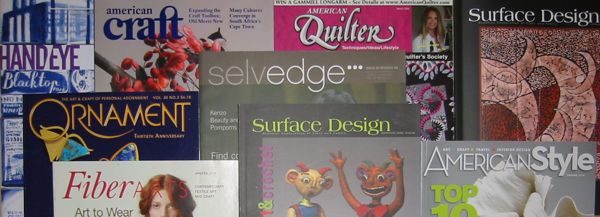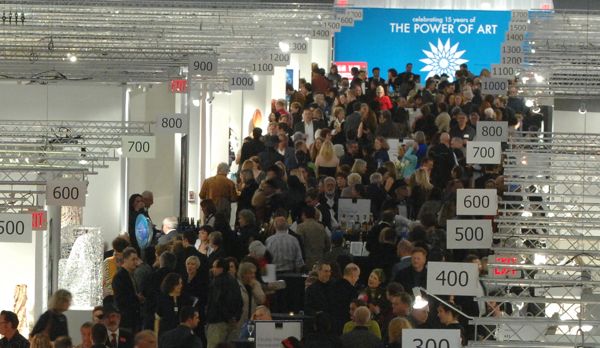Guerilla Marketing for Designers
April 22, 2010
Since you can never have too much good advice about how to promote yourself and your work, NewsBlog Invited Expert Susan Harkavy generously agreed to share some tips for successful self-promotion with SDA members.
Harkavy is a public relations consultant  specializing in contemporary design, home furnishings and lifestyle, with 27 years experience in the industry. The former head of PR for the American Craft Council, she went on to represent furniture designer Dakota Jackson prior to founding her own firm in 1994. Susan works with designers one-on-one to hone effective communication techniques and develop strategies for successful promotion. She teaches guerrilla marketing at New York Designs in Queens, NY, a resource center for business counseling and education. Here are the insights she shared with NewsBlog editor Leesa Hubbell:
specializing in contemporary design, home furnishings and lifestyle, with 27 years experience in the industry. The former head of PR for the American Craft Council, she went on to represent furniture designer Dakota Jackson prior to founding her own firm in 1994. Susan works with designers one-on-one to hone effective communication techniques and develop strategies for successful promotion. She teaches guerrilla marketing at New York Designs in Queens, NY, a resource center for business counseling and education. Here are the insights she shared with NewsBlog editor Leesa Hubbell:

PR Consultant Susan Harkavy
LH: Artists and designers need to promote themselves and their work but often feel they can’t afford to hire a PR person. You specialize in the concept of “guerrilla marketing“—or the affordable actions any type of creator can take to market their work. What are some basics steps you suggest for SDA members–who position themselves across the marketing spectrum as crafters, artists and designers?
SH: We say “fish where the fish are.”
If you first define your audience(s), you can fairly easily imagine where they gather (conferences, trade shows, lectures, exhibitions, openings, parties, show houses, trunk shows), whom they trust (critics, curators, editors, industry leaders, lecturers, prominent retailers, art dealers) and what they read, watch and listen to (key publications, blogs, tv and radio shows).
Once you get specific and list the relevant names for your situation, it’s a straightforward matter of deliberately contacting them. Whether it’s a program director who can ask you to lecture, a gallery that can exhibit your work, an editor who might publish you, or a manufacturer who might license your design, the guerrilla strategy is to make the lists then pro-actively get in touch.
LH: What should you do when you realize that in order to achieve the visibility you want,
you need to pay a PR professional? What advice could you give to someone looking for the right person and level of service?
SH: Look for a PR person or firm who specializes in what you do, rather than a generalist. S/he will be familiar with your industry, know the language and the players, know what makes something news, have achieved visible results, and have the connections to be successful. Go to websites of notable people in your field; look at the press page and see if a PR firm is listed, or ask editors of important publications for suggestions of which PR people are good.
Once you’re interviewing, ask for a client list to confirm s/he works with studios like yours. Read writing samples. Ask to see a press clippings portfolio and case studies. Call past and current clients to see if they had a good experience. Call editors and ask if the PR person is known to them.
 LH: Why don’t people realize that good PR advice is well worth the money? What does a PR professional provide that an individual can’t do or get on their own?
LH: Why don’t people realize that good PR advice is well worth the money? What does a PR professional provide that an individual can’t do or get on their own?
SH: Perspective. We all get too close to our own story. A good PR person can position you, help you articulate what makes you unique, assist in developing promotional materials and story hooks, create a strategic marketing plan, help you define your goals, make introductions and open doors. However, many potential clients ask me if the media would rather hear from a PR person they know than from an unknown designer. That answer is usually no.
The media CRAVES new talent, and is constantly seeking the next new thing. So while a PR person can certainly make a call and get your name in front of an editor, the editor is just as happy to hear from you directly.
LH: You help designers make use of trade shows–like the International Contemporary Fine Furniture show in May each year (concurrent with SURTEX at the Javits Center in New York City). How can designers who are not exhibiting make use of events like this? How could similar tactics work for any maker at any exhibition or event that relates to the work they make?
SH: In an article I wrote on party schmoozing, I said that “more business gets done with a drink in your hand than is ever accomplished from your desk.”
Face-to-face contact is the first step in establishing relationships that will encourage people to take your calls, pass your name along and sign your contracts. So even if you are not exhibiting in said trade show, take advantage of the confluence of so many people in your industry – and make it a point to forge new contacts there. Introduce yourself to exhibitors and program speakers. Go to satellite events and parties and talk to fellow attendees: What brought you here? Did you go to the trade show? What else have you seen that’s great?
LH: Speaking of networking, creative people are often introverts. They think networking means forcing yourself to schmooze with people at openings in order to make connections that will help them get noticed. What’s your take on networking that works?
SH: Networking does include schmoozing at openings, a very easy way to talk to strangers because you have a built-in topic: what’s on exhibit. Don’t go it alone: bring a friend who can talk about you, or split up and then introduce each other to the new people you’ve met. Choose a party based on the likely audience (back to “fish where the fish are”). Ask to meet the host, then ask the host whom else you should meet.
Before a trade show, look up exhibitor websites and find “like minds”; write them in advance to admire their work and start a conversation you can then complete in person. Or volunteer for your favorite cause; there’s no better way to establish your personality and smarts than to work side by side with people on a committee.
LH: Women–of all generations–often feel that talking about their accomplishments is boastful, arrogant, blatant self-promotion. They are often too modest, and thus sabotage the possibility of attracting the attention their work deserves. Any tips for busting through this conditioning?
SH: There’s a difference between talking about what you do, and putting a judgment on it. Ilise Benun, www.marketing-mentor.com and author of Stop Pushing Me Around, notes: “Creative professionals tell me every day that one of the reasons they don’t feel comfortable promoting themselves is because their mother told them not to brag. But talking about your work is not the same as bragging.
Bragging involves adjectives and adverbs (“I am the best designer in town.”) which you should never say. Talking about your work involves nouns and verbs about the way you work and who it’s for; in other words, objective, factual information that is relevant and useful to your prospect.”
(Susan also recommended Networking for the Terminally Shy from Terri Lonier’s website workingsolo.com -Ed.)
LH: Any final thoughts on creating buzz?
SH: Use every opportunity to talk about what you do because you never know who might be looking for what you’re selling. The person passing your name along might be your college roommate, your cousin, your dentist, your neighbor, the person who swims in the next lane at the pool, the lady ahead of you in line at the cleaners or your Mac tech consultant. In other words, the leads don’t always come from your professional circle.
If you can create an image in the listener’s head, something that causes him to think, “I know someone you need to meet,” …then you are golden.






2 Comments
Jan Myr Johnson says
February 2, 2015 at 5:59 pm
I am a "retired" woman who is starting to do a lot of fabric (wallpaper/gift wrap) designing. I am excited by the results and joy I feel as I create. I am totally stymied by the marketing aspect, and have just started to learn more about this. I came across this article and am excited all over again. What wonderful ideas. I feel infused with courage. Thanks.
NewsBlog Editor says
February 6, 2015 at 11:29 pm
Thanks so much for letting us know Susan's article was helpful, Jan. Joining SDA is a great way to connect to the textile arts community at any stage of your creative growth. Since you clearly love textiles, you already belong. Please visit our website to consider joining us for the many benefits at https://www.surfacedesign.org/get-involved/join-sda-great-member-benefits
Related Blog Articles
No Thumbnail Available
Invited Expert
Creative Process: Spinning an ART YARN with Inspiration from ravelry.com